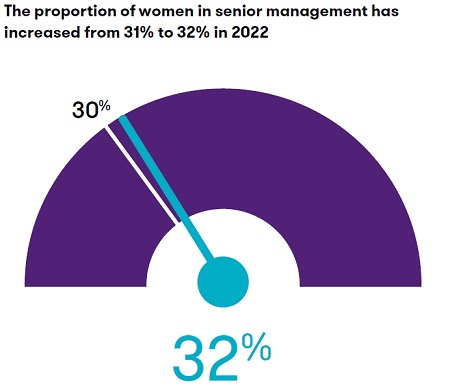
Our 2021 Women in Business report identified a window of opportunity created by post-pandemic working practices that were enabling more women to move into senior roles. In 2022, as economies slowly recover and the worst impacts of the pandemic recede, that trend looks set to continue.
Diversity, equity and inclusion Women in business reportFind out the latest results
In this year’s data, we see mid-market businesses across the world taking decisive action to mould more flexible working practices around the needs of their people. They say that they are prioritising employee engagement and modelling open, inclusive working environments. By so doing, organisations are opening the door to bring female talent into senior positions in greater numbers than ever before.
“It is essent
ial for companies to become more equal,” says Anna Johnson, CEO of Grant Thornton Sweden. “It is a requirement for being attractive to both customers and employees. Gender equality is something we as leaders must prioritise every day, in every decision we make.”

Deliberate, continued action by businesses has resulted in an increase in the proportion of women in senior management around the globe. Women now hold 32% of top leadership positions, up from 31% in 2021. These include chief executive officer and managing director, chief finance officer, chief information officer, chief operations officer, chief marketing officer and human resources director roles. The increase continues the linear growth plotted over recent years. In the last decade, we have seen the proportion of female leaders grow by 11 percentage points, up from 21% in 2012.
Across the 5,000 business leaders in 29 countries surveyed by Grant Thornton, 90% record their business as having at least one woman in the C-suite or equivalent. Regionally, there has also been positive progress, with every area we report on equalling or passing 30% of senior roles held by women.
“These numbers are a reflection of an awakening by leaders of how important it is to have a diverse environment, and of stronger efforts on their part to build a more inclusive culture,” says Kim Schmidt, global leader – leadership, people and culture at Grant Thornton International. “That has accelerated the creation of safe, more authentic environments for all employees over the last few years.”
An increase in gender diversity at the top level leads to business benefits, particularly in light of the global shortage. With traditional business models being challenged in favour of more fluid structures, and recruiters widening their nets to draw from a global talent pool, businesses are having to compete harder for individuals with the abilities to lead and succeed in the new business landscape.
Grant Thornton’s International Business Report research reveals that 57% of mid-market organisations expect talent shortages to be a major constraint to their businesses over the next 12 months. A record level of talent churn, being termed the ‘great resignation’, is adding to the pressure to retain and attract the best people.
With employees re-evaluating their work-life balance and reconsidering the route of their career paths in the wake of the pandemic, businesses are having to be more authentic in building environments where their people can find purpose. A central element of this is to tailor working models to individual employees, making it easier and more appealing for them to remain with their employers as their life priorities shift.
A specific focus on opening up opportunities for women to move into senior roles through more flexible working practices will be a major way of tackling the talent shortage. Our 2022 Women in Business report explores the ways in which organisations can open the door for more diverse people – and empower them to step through to future success.
Female talent is an essential resource and vital to good business outcomes, as well as fundamental to bridging the skills gap. Forward-looking organisations are already collaborating with employees to remodel working setups in order to allow all candidates the opportunity to achieve equity in seniority.
As these new working models become embedded and greater flexibility in employment practices is regarded as the norm, the opportunities for uninterrupted female career progression will increase. We are optimistic that this, along with continued, deliberate action by businesses to engage all of their people in an inclusive workplace – virtual or otherwise – will result in the continuing increase in female leadership.
With global numbers for senior women remaining consistently past the 30% tipping point – the proportion needed to spark significant positive momentum – over the last two unsettled years, we also hope to see an acceleration in the growth of female representation at senior management level.
“The numbers we are seeing currently may be the beginning stage of a significant change, rather than the tail end of previous progress,” suggests Kim Schmidt. “It could be that new people are just starting to move into senior roles. It will be fascinating to see what happens in 12 months after a full year of significant movement.”